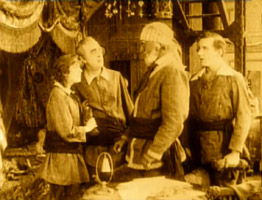Santa, the pirate look doesn’t really work for you…
In 1916, Universal Studios released the first filmed adaptation of Jules Verne’s novel 20,000 Leagues Under the Sea. Georges Méliès made a film by that name in 1907, but, unlike his earlier adaptations of Verne, Méliès’ version bears no resemblance to the book. In Universal’s effort, we are looking at the earliest surviving full-length big-budget science fiction film. And already the rot had set in.
I can just imagine Carl Laemmle and the director sitting there in some office on Lankershim Boulevard, when this thing was in development. “Say, this is swell! We’ve got a hot property by a best-selling author! We have THOUSANDS of dollars to spend on special effects! The American public will go crazy over it! But, you know… all that science and exploration and philosophy stuff is box-office poison, so let’s bring in some scriptwriters to make a few changes in the story.”
Yeah. That rot.
You know this drill already, right? The “We don’t care if he’s a bestselling author, we have to change his story so it’ll appeal to people now” line? The “Gotta stick a love interest in there somewhere” line? The “Who cares if it’s stupid? We have SPECIAL EFFECTS” line? To be fair, the special effects were impressive for the time. Mostly. George and J. Ernest Williamson pioneered a system of underwater photography without actual underwater cameras, and their shots of fish and coral reefs seen through crystal-clear Bahamian water must have astonished people in 1916. Less effective is the giant prop octopus, which looks as though your average middle-school class could have built it for a parade float. It’s still a better piece of construction than the script.
And oh, the script. It starts out reasonably faithful to Verne’s book: Professor Aronnax and Ned Land are introduced, but a daughter is invented for Aronnax and stuck into the plot for no apparent reason. The three are knocked from the deck of the Abraham Lincoln into the sea, and rescued by Captain Nemo in his super-submarine the Nautilus. Nemo is played by Allen Holubar, an actor who conveyed extremes of emotion by smacking the back of his fist against his forehead and sagging forward. He treats his prisoners (and the audience) to a session at his private viewing porthole, where the wonders of the undersea world can be seen.
Here the scriptwriters seem to have lost faith in Verne’s (and the special effects’) ability to keep an audience interested, because the plot and characters of Verne’s The Mysterious Island are dragged in, and that ain’t all: a Wild Girl who lives as a Child of Nature on the island is created. Her Child of Nature frolicking is on a par with Holubar’s acting style. One longs to hear what Servo, Crow and Joel might have said about it… Anyway, she’s the love interest, falling for one of the handsome Yankees stranded on the island. It just gets worse after that.
Cyrus Harding’s servant Neb is played by Leviticus Jones, apparently an actual black actor, without any eye-rolling or minstrel-show comedy. Just as I was awarding the movie points for enlightened attitude, Neb was attacked by the prop octopus, rescued by one of Nemo’s crew, and thrown back in his boat to drift out of frame. Apparently the script writers forgot about him, because he is never seen again. Nemo and his long-lost daughter the Child of Nature (of course she turns out to be his daughter!) wear a sort of Asian blackface, and a huge flashbacked plot digression (“Captain Nemo’s Origins—the story Jules Verne never told”) tells how a lustful member of the British Raj attacked Nemo’s wife and stole his little daughter, only to abandon her on a desert island. Flash forward to the present and the remorseful Brit sails back to the island in his yacht, where he proceeds to get lost and faint a lot.
I could go on and on, but it’s probably enough to say that Disney, in the 1950s, did a much better job with their version. Let me close this on a brighter note, with a sweet bit of historical speculation: the French inventor Brutus de Villeroi, who built the U.S. Navy’s first submarine, tested his prototype in the harbor at Nantes back in 1835, when Verne was seven years old. Verne was born and raised in Nantes. Did he watch the prototype submarine being tested? Did a spark jump in the child’s mind? Was that the moment when science fiction was born?










